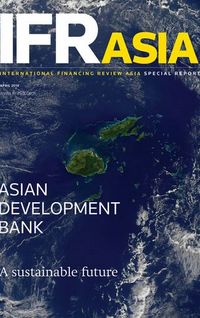The ADB is investing more in bonds and equities across Asia as it looks to double support for the region’s private sector over the next five years.
The head of the ADB’s private sector operations evidently has a healthy appetite for risk. Ahead of the 2019 annual meetings, Mike Barrow will be spending some of his free time deep underwater surrounded by sharks.
Barrow may be an experienced diver, but his sense of adventure will stand him in good stead as the bank scales up its exposure to Asia’s private sector.
The ADB’s long-term strategy calls for Barrow’s department to make more commercial investments in companies and projects that are not government-owned, with the goal of filling gaps in the market and making money to boost its resources.
The expansion has already transformed the bank’s role in the capital markets, for instance. It is ramping up pre-IPO investments in Asian equities and supported listings in the energy and healthcare sectors in 2018. While the ADB has a long history as a bond issuer, it has recently appeared on the other side, investing in private sector bonds that promote sustainable development.
With growth comes more intense scrutiny.
“Two of the four numerical targets in Strategy 2030 are aimed directly at me,” said Barrow.
He’s only half-joking. The ADB’s long-term plan, approved by the bank’s governors in 2018, calls for the private sector department to account for one third of all operations by 2024, and for all private sector disbursements to mobilise at least US$2.50 of cofinancing for every US$1.00 of ADB money by 2030. (The other hard targets relate to gender equality and climate change.)
The division has already been growing rapidly. In 2018 the ADB signed more than 30 private sector deals for a record total of US$3.1bn, and mobilised a record US$6.4bn of cofinancing – well on the way to the long-term 2.5:1 target. The next five years, however, come with a big expansion push that will require more people and a much broader range of projects.
“In terms of number of signed deals, we’d like to double from around 30 to 60-ish annually,” said Barrow. “That will require a big change in our ability to process and manage that many deals.”
The 2024 target is a numerical test, rather than a volume target, to incentivise staff to work on transformational private sector projects that carry a lower dollar value – for example in the Pacific Islands or other small economies.
The bank is also pushing to diversify into new sectors, such as transportation, water, sanitation, telecoms and health.
“We have been very heavy on power and energy. That of course will be core still, but we’d like to do a lot more non-power infrastructure,” said Barrow.
The ADB has added expertise in agriculture and social sectors in recent years, and is now recruiting for a business development team to study early-stage incubation investments, especially around new technologies and climate change.
“We will work with our donor partners to create platforms where money and expertise can be put in to help grow a whole swathe of new Asian companies focused largely – but not exclusively – on climate change,” said Barrow.
Market development
The newest team in Barrow’s department will focus on equity investments, both in private equity funds but also directly into projects or through equity stakes in companies focused on developing infrastructure.
The bank can point to recent successes, such as pre-IPO stakes in Gulf Energy and B Grimm in Thailand, which have both performed handsomely since listing in 2018. It also helped anchor the IPO of Indonesian hospital group Medikaloka Hermina in difficult market conditions last April.
“We have really committed to equity under Strategy 2030,” said Barrow. “Right now it’s around 10% of the private sector portfolio, and we’d like to increase that.”
The cofinancing target of 2.5:1 has already had an impact on the guarantee and syndications unit, which is pushing to take a more senior, lead arranger role in projects.
“If we’re confident we can help arrange a financing and put it together, then we are happy to take that role,” said Barrow. “We haven’t had the scale to do that consistently before.”
The ADB has also enhanced its determination to promote Green bonds, leading to novel investments in bond issues from B Grimm and AC Energy.
The bank invested Bt5bn (US$155m) in a five-year and seven-year Green bond from Thailand’s B Grimm Power in December, the first certified climate bonds to be issued in Thailand. The private placement extended the bank’s relationship with B Grimm, following previous loans and the pre-IPO investment, and filled a gap for the company in the tricky seven-year maturity segment.
It also invested US$20m in a US dollar climate bond from Philippine power company AC Energy, part of the Ayala group, in January. Unlike the Thai baht issue, the ADB acted as an anchor investor in a public deal, helping AC Energy to add a US$110m 10-year tranche to a five-year Green bond. The Singapore-listed deal was a first from the Philippines, where previous Green bonds have all been private placements.
“There is a common misconception that the ADB does not do bonds,” said Jackie Surtani, a director in the private sector operations department. “Helping companies diversify their funding sources is part of our job.”
The ADB intends for its bond market investments to ‘crowd in’ other buyers, helping to develop the capital markets and promote best practice in an emerging sector, such as reporting obligations or certification of Green or Social bonds.
“We are not going to buy every Green bond,” said Barrow. “If it’s leading the market, or if there is a market gap … that’s where you will see us.”
Blended finance is another area of focus. The ADB does not have its own donor window, in contrast to the World Bank, which has allocated US$2.5bn from the concessional IDA pool to mobilise private sector investments. But it is keen to work with donor partners, such as the Canadian Climate Fund for the Private Sector in Asia. The Canadian fund, which was established in 2013 and expanded in 2017, has supported investments in wind power in Indonesia, solar energy in Cambodia and Samoa.
More recently, the fund provided a technical assistance grant for a solar energy project in Mongolia, to be funded by the ADB and the Leading Asia’s Private Infrastructure Fund (LEAP), a cofinancing fund seeded by the Japan International Cooperation Agency and administered by the ADB.
The bank is also keen to expand the LEAP concept to the private sector, with a commercial partner taking JICA’s place. The model, where the cofinancing partner would automatically invest alongside the ADB in projects that meet its objectives, could appeal to major insurance companies looking to increase their exposure to long-term infrastructure assets in the region.
Barrow is also keen to consider other financing tools, such as securitisation, though he notes that the focus will remain firmly on investments with a high development impact.
“Normally our thinking is our money should be used for new development,” he said. “However, there is a counter argument that if you free commercial banks to do more and create a new asset class, then that is also developmental.”
To see the digital version of this roundtable, please click here
To purchase printed copies or a PDF of this report, please email gloria.balbastro@tr.com



